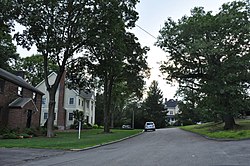West Newton Hill Historic District
West Newton Hill Historic District | |
 | |
| Location | Roughly bounded by Highland Ave., Lenox, Hampshire, and Chestnut Sts., West Newton, Massachusetts |
|---|---|
| Area | 35.9 acres (14.5 ha) |
| Architect | Taylor,Bertrand |
| Architectural style | Colonial Revival, Queen Anne, Shingle Style |
| MPS | Newton MRA |
| NRHP reference No. | 86001766[1] |
| Added to NRHP | September 4, 1986 |
The West Newton Hill Historic District is a residential historic district in the village of West Newton, in the city of Newton, Massachusetts in the United States. It is composed of a cohesive collection of spacious houses built in the second half of the 19th century, representing the development of the West Newton area as a fashionable railroad suburb.[2] The district was listed on the National Register of Historic Places in 1986.[1]
The Boston and Worcester Railroad was built through West Newton in 1834, leading to its first significant period of growth. At this time, Chestnut Street was laid out across the hill south of the railroad line, and several houses were built. The improvement of regular passenger service in 1843 spurred further growth in the village, and in 1849 developers hired Alexander Wadsworth to lay out an 80-acre (32 ha) subdivision on the hill. Ten houses were built before 1879, and the majority of the development took place between 1880 and 1900. The district includes 36 acres (15 ha) of these subdivisions, with 58 contributing houses that are predominantly Queen Anne, Shingle, and Colonial Revival in their styling. Only six houses were built in the area after 1936.[2]
One of the oldest houses in the district is 12 Valentine Street, a Greek Revival house that was moved into the area, and is believed to include timbers used from an early farmhouse. There are two Second Empire houses, at 152 Chestnut and 292 Otis Street, and only a few more Italianate houses. Chestnut Street is lined by a significant number of Queen Anne houses, notable among them 170 Chestnut, which features the asymmetrical styling and varied gables, dormers, and projections typical of the style. The houses at 332 and 334 Otis Street are nearly mirror images of one another, with off-center projecting pavilions and hip roofs.[2]
The district is bounded on the west by Chestnut Street, running just south of Westfield Road to Highland Street, and on the north by Otis Street from Chestnut to Lenox Street, which defines the eastern boundary. The southern boundary Valentine and Highland Streets, omitting the houses south of those roads except for those within the triangular junction of Valentine Street with Burnham and Hampshire Roads.[2]
See also
References
- ^ a b "National Register Information System". National Register of Historic Places. National Park Service. March 13, 2009.
- ^ a b c d "NRHP nomination for West Newton Hill Historic District". Commonwealth of Massachusetts. Retrieved 2014-04-22.
- National Register of Historic Places in Newton, Massachusetts
- Queen Anne architecture in Massachusetts
- Shingle Style architecture in Massachusetts
- Colonial Revival architecture in Massachusetts
- Historic districts in Middlesex County, Massachusetts
- Historic districts on the National Register of Historic Places in Massachusetts


